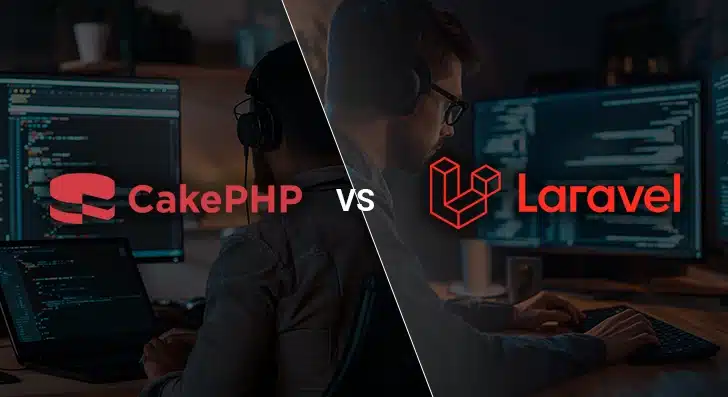If you are browsing the web, there’s a strong chance you’re on a PHP-powered website. PHP has evolved significantly since its introduction three decades back. Today, it is used by 76.4% of all websites where the server-side programming language is known. That’s nearly three-quarters of the web.
PHP is a widely used technology. It remains a major player even with the rise of new technologies like Blockchain, AI, Machine Learning, IoT, Augmented Reality, and Virtual Reality. PHP’s stronghold in web development stems from its many frameworks.
These frameworks provide developers with pre-built components. They allow development teams to add custom features and functionalities to web applications. Many times, this can be done without the need for third-party tools.
Today, a large number of PHP frameworks are available. Among them, CakePHP and Laravel stand out as favored by web developers.
At first glance, both CakePHP and Laravel may look similar on the surface.This is because both the frameworks are written in PHP, are free and open-source in nature, and follow the model–view–controller (MVC) architectural pattern. They are also backed by a large and active developer community. However, the real difference between both frameworks can be unveiled by dissecting their benefits, features, development costs, and more. Let’s talk about these differences in this detailed and informative piece.
Table of Contents
- What is CakePHP – A Quick Rundown
- What is Laravel – A Quick Rundown
- CakePHP vs Laravel: Pros and Cons
- Popular Web Solutions Engineered with CakePHP
- Popular Web Solutions Engineered with Laravel
- Laravel vs CakePHP: A Side-by-side Comparison
- CakePHP vs Laravel: A Detailed Comparison
- CakePHP vs Laravel: Development Costs
- Summing Up
What is CakePHP: A Quick Rundown
CakePHP emerged in 2005 as a free, open-source, rapid development framework that makes PHP web application development simpler. Michal Tatarynowicz founded this framework, which uses the model-view-controller (MVC) architectural pattern to separate data into three logical components for better management.
CakePHP is widely used for developing and maintaining web applications. Developers can leverage its flexibility to create microservices web applications that load rapidly. Furthermore, it has built-in support for safe request handling, business logic, validation, unit testing, and other similar capabilities. CakePHP also provides robust support for databases like SQL Lite, MYSQL, PostgreSQL, and more. Since the framework operates on a document-oriented database model, it facilitates data storage in JSON format instead of rows and columns. To date, there are over 36,000 live websites using CakePHP, making it a popular PHP framework.
What is Laravel: A Quick Rundown
“As the creator of Laravel, it’s a profound privilege to continue developing a framework that empowers developers and companies around the world. Laravel’s mission has always been to help teams ship amazing, well-tested, and beautifully architected applications quickly and with confidence. It is an honor to see the incredible solutions our community builds every day, and I’m grateful to play a role in supporting their success.”
–Taylor Otwell, Creator of Laravel
Laravel ranks among the world’s leading frameworks. Taylor Otwell developed it and released the first version in June 2011. The framework emerged as a fresh alternative to older tools. It brought a cleaner syntax and modern approach to PHP development.
Laravel is widely used for creating dynamic and fully functional web applications. It comes with an expressive command-line interface (CLI), which eliminates the need for repetitive, tedious, and manual coding tasks. Furthermore, it supports concurrent unit testing, empowering PHP Laravel developers to not only test multiple units at once but also prevent potential errors that arise due to unexpected changes. Today, Laravel is recognized as one of the most popular PHP frameworks owing to its Object Relational Mapping (ORM) features that make database operations smooth and intuitive.
CakePHP vs Laravel: Pros and Cons
Pros of Using CakePHP
- Easily Readable
Cake PHP facilitates the creation of reusable code components that can be used across many web development projects. Instead of adding new libraries, the functionality can be transferred to components, plugins, helpers, and behavior. - No Pre-Configuration Required
Another key advantage of using the CakePHP framework is that it saves developers’ time by automatically performing the configuration settings that need to be made. This means that developers don’t need to invest time in configuring Linux Apache MySQL PHP setup. - Object-Relational Mapping
CakePHP includes a built-in ORM (Object-Relational Mapping). The ORM simplifies database interaction. It also improves code readability by allowing web developers to work with databases using an object-oriented syntax. - Built-In Libraries
With built-in modules and libraries, CakePHP allows developers to quickly build robust and adaptable websites and web applications. - Active Community
CakePHP is backed by an active community of developers that is committed to providing end-to-end support and enhancing the capabilities of this open-source framework. - MVC Architecture
CakePHP uses the MVC (Model-View-Controller) pattern. This architecture helps developers organize their code better. It also splits applications into three connected parts, making it easier to reuse code and maintain it better over time. - Database Support
CakePHP supports various databases. These include MySQL, SQLite, PearDB, SQL Server PostgreSQL, and Oracle. This gives developers the flexibility to pick the right database for their project needs. - Rich Documentation
CakePHP offers comprehensive and up-to-date documentation, including tutorials, guides, and API references. These resources help developers navigate common workflows and tasks. They show how to handle form submissions, set up authentication and authorization, and tackle other essential processes. - Built-In Features
CakePHP comes packed with many built-in features. These include data validation, scaffolding, ORM (Object-Relational Mapping), authentication, and caching. These features make web development easier and remove the need for third-party tools.
Cons of Using CakePHP
- Steep Learning Curve
There is a steep learning curve for developers not familiar with MVC (Model-View-Controller) architecture. - Community Size
Compared to other PHP frameworks like Laravel, the community size of CakePHP is relatively small. A smaller community means fewer community-driven resources, plugins, and packages. - Ecosystem Maturity
While CakePHP has been around for nearly two decades, the ecosystem of this open-source PHP framework might not be as mature as other frameworks.
Mastering the Web Development Landscape with PHP
Pros of Using Laravel
- Blade Templating Engine
Laravel comes with a robust and intuitive tool that provides developers with a clean and concise syntax for writing templates. It also supports features like template inheritance, loops, conditionals, and partials, enhancing developer productivity, encouraging code reusability and maintainability, and contributing to the readability of Laravel applications. - Artisan Command Line Interface (CLI)
Laravel’s Artisan Command-Line Interface (CLI) is a powerful tool. It provides several helpful commands to streamline the development workflow, automate repetitive tasks, generate boilerplate code, seed databases, run migrations, clear caches, and manage various aspects of a Laravel application. This results in enhanced developer productivity. In other words, Artisan CLI empowers PHP Laravel developers to build high-quality applications faster and more effectively. - MVC Architecture
Laravel follows the Model-View-Controller (MVC) architectural pattern. This promotes the separation of concerns into distinct components. The architecture also improves code organization, maintainability, and scalability, making it easier to manage complex applications. The MVC architecture also improves collaboration among development teams by providing a clear and consistent structure for code organization and communication.
Cons of Using Laravel
- High Development Cost
Though Laravel is free and open source in nature, hiring Laravel developers for web development is a costly affair as compared to other frameworks. - Limited Support
Unlike other open-source frameworks, support for Laravel is not readily available, and this might increase the risk of system downtime. - No Built-In support function
Unlike Ruby on Rails and Django, Laravel has limited built-in support.
Popular Web Solutions Engineered with CakePHP
CakePHP powers some of the popular names, including BMW, Edureka, Hyundai, SeatGeek, Form Assembly, and more. Given the list featuring popular brands using CakePHP, you might wish to leverage the potential of this open-source PHP framework. If you do, you may hire top CakePHP developers from a reliable web development company.
Popular Web Solutions Engineered with Laravel
Websites like Alison, October, Invoice Ninja, Barchart, MyRank, AsgardCMS, World Walking, Neighbourhood Lender, and more are built using the Laravel framework. If you also wish to craft a popular web solution using this framework, you may hire top Laravel developers from a professional PHP development company.
Laravel vs CakePHP Performance: A Side-by-Side Comparison
| Category | CakePHP | Laravel |
|---|---|---|
| Speed | Faster than Laravel | Not the fastest |
| Routing | Easy to implement | Difficult to implement |
| Data Backup | The data backup option is limited | Better data backup options |
| Templating Engine | Doesn’t provide a flexible templating engine | Flexible template engine |
| Data Handling | Not as efficient as Laravel | Highly efficient |
| Security | More secure than Laravel | Good security |
CakePHP vs Laravel: A Detailed Comparison
This detailed comparison between CakePHP and Laravel will help you understand the key differences between both frameworks. Let’s have a look.
CakePHP vs Laravel: Plugins
CakePHP
CakePHP offers a host of plugins that not only keep the code clean, organized, and efficient, but also make the application readable and compact. The plugins also support critical functions like security, authentication, migration, debugging, and asset management.
Laravel
Unlike CakePHP, Laravel does not provide a wide assortment of plugins. This leads to poor reusability within the code.
Winner – CakePHP
CakePHP vs Laravel: Performance
CakePHP
CakePHP has undergone performance improvements over the past few years. It utilizes caching mechanisms and an ORM (Object-Relational Mapping) system to improve application speed. In certain scenarios, CakePHP may deliver slightly faster performance owing to its simpler architecture.
Laravel
Laravel, on the other hand, excels in performance due to its optimized database query builder and efficient routing system. Being a more recent framework, Laravel benefits from better template engines, modern optimization techniques, and a rich ecosystem of tools and packages that contribute to performance enhancements and optimizations.
Winner – It’s a Tie
CakePHP vs Laravel: Scalability
CakePHP
Built on the MVC architecture, CakePHP is best suited for small-scale web development projects that require less complexity. Though large-scale applications can be developed in CakePHP, it is a piece of cake in Laravel.
Laravel
Laravel is considered ideal for complex, large-scale web development projects. Using this framework, developers can build fully functional eCommerce stores and enterprise-level web applications with ease.
Winner – Laravel
The Ultimate Guide to Hiring PHP Developers Right the First Time
When to Choose CakePHP for a Web Development Project
Choose this open-source PHP framework when planning to develop web solutions with limited functionalities.
When to Choose Laravel for a Web Development Project
It’s considered wise to choose this framework for building web solutions that demand faster time-to-market.
CakePHP vs Laravel: Development Costs
The cost of development varies significantly between CakePHP and Laravel projects. CakePHP development costs showcase the framework’s efficiency. Companies with tight budgets find CakePHP’s reasonable cost structure appealing. The framework’s modular design keeps initial costs low by including just the core functions in the base version. More features can be added through extensions whenever needed. This avoids unnecessary upfront expenses.
Laravel development comes with higher price tags. Laravel developers charge between $25 to $150 per hour based on their skills and location. Project prices also reflect this. Simple website projects start at $3,000 and can go beyond $100,000 for enterprise applications.
The location of developers plays a big role in pricing for both frameworks. Developers in North America and Europe charge more than their counterparts in Asia and Latin America. Skilled developers cost more but deliver better code quality and faster implementation. This potentially reduces long-term costs.
The project’s complexity also drives costs up. Custom designs, advanced features, and third-party integrations increase development costs regardless of the framework chosen. Laravel projects often need larger initial budgets because of their extensive feature set and sophisticated architecture.
Yearly maintenance adds about 15-20% to the original development costs. Smaller Laravel projects need $100-$300 monthly for upkeep. Complex applications require $1,000-$5,000 monthly.
Laravel projects need more money upfront. However, its scalability and rich features lead to lower long-term costs for complex, evolving projects. CakePHP works better as a budget-friendly option for teams with standard requirements and limited funds.
Region Wise Average Hourly Rate in USD
| Region | CakePHP | Laravel |
|---|---|---|
| North America | $38 – $65 | $60 – $120 |
| Australia | $38 – $58 | $40 – $100 |
| Western Europe | $35 – $55 | $50 – $110 |
| South America | $22 – $38 | $25 – $70 |
| Eastern Europe | $18 – $32 | $30 – $80 |
| Asia | $15 – $25 | $20 – $60 |
Source: clouddevs.com
Summing Up
CakePHP and Laravel are powerful PHP frameworks, each with their own strengths and limitations. CakePHP shines with smaller, straightforward applications where speed matters the most. Laravel works better for complex, enterprise-level applications that need more room to grow. Its clean syntax, complete feature set, and resilient ecosystem make it ideal for applications that will expand over time.
Money also plays an important role in framework selection. CakePHP is the more economical choice for businesses watching their budget. Developer rates usually range from $38-65 per hour. Laravel developers charge more, somewhere between $60-120 per hour. This makes sense since Laravel ranks as the most popular PHP framework among developers.
These frameworks also differ in technical aspects. CakePHP comes with lots of plugins that keep code clean and organized. However, it slows down when dealing with huge databases. Laravel might not have as many plugins, but it handles large datasets better thanks to its optimized database query builder and quick routing system.
When picking a framework, companies should focus on their specific needs instead of following trends. Small businesses with basic requirements could benefit from CakePHP’s speed and lower costs. Bigger companies planning major growth might find Laravel’s scalability worth the extra investment.
The right framework ultimately depends on your project’s scope, budget, timeline, and future needs. Both frameworks improve with regular updates, security fixes, and community support. This makes them solid options for PHP projects of any size or complexity.







